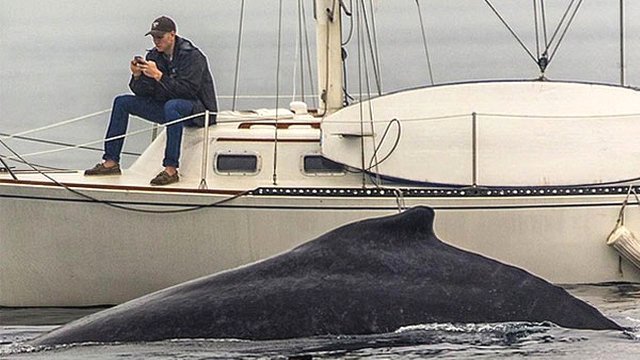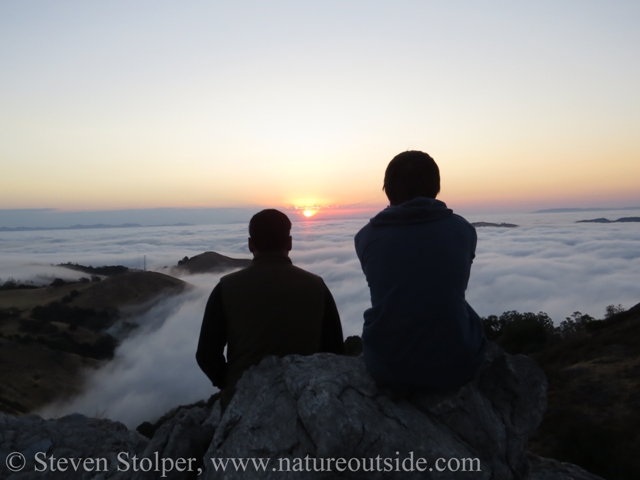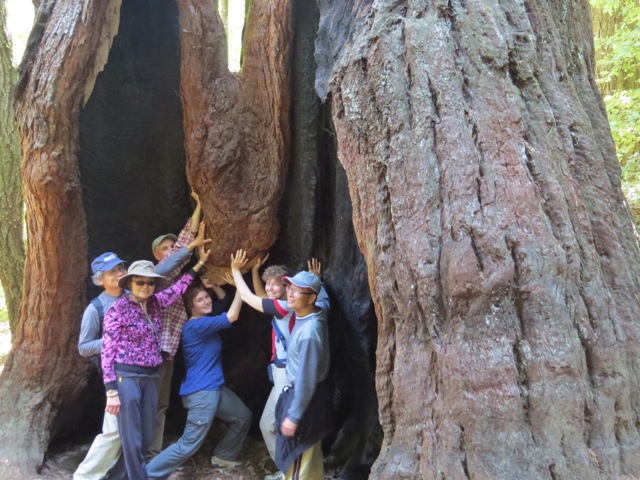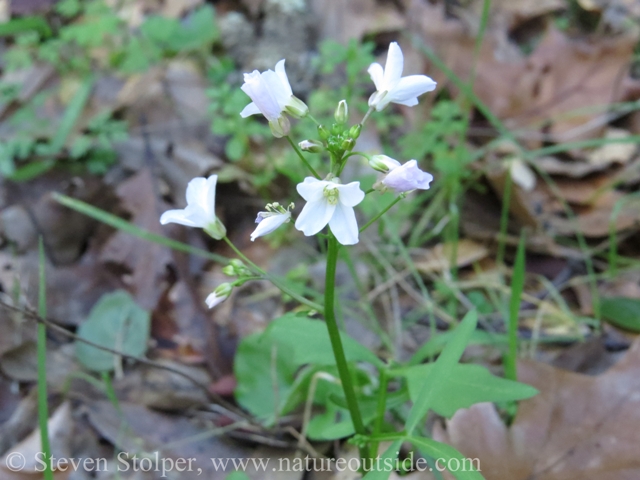
(Photo by Eric Smith)
Look at the picture above. Look closely.
What do you see? I see a man, a boat… and a California Gray Whale! If you see the whale, then you’re one step ahead of the man on the boat. 🙂
Eric Smith, a CBS employee, took this picture during a day out on the water. Here is what Smith told CBS News:
A mom was out there with her calf, flapping, breaching, jumping, mouths eating fish — it was fantastic… he never moved from his phone.
I’ve been there, I get lost in the phone too. But this is really indicative that we have some serious issues to work through.– Eric Smith
What are the issues to which he refers? Why are they important?
Our Relationship with Nature
Every day, bend and kiss the ground and be thankful you’re here.
– Valentin Lopez, Chairman of the Amah Mutsun Tribal Band
I was fortunate to be in the audience when Chairman Lopez spoke these words. His speech concluded a day of lectures about the Amah Mutsun’s effort to relearn traditional living skills. What I call bushcraft.
His words struck the perfect chord to end the day. We had already heard from speakers how traditional land management practices benefit both humans and the environment. They create a mutualistic relationship between man and nature. This relationship produces healthy people and healthy, diverse ecosystems.
Chairman Lopez’s words enjoin us to remember our greater connection to nature. But they also give us the key to this relationship: mindfulness! Being mindful, observant, and attentive to nature enhances our relationship with the natural world,
This brings us back to the photo above. Do mobile electronics in the wilderness enhance or detract from our relationship with nature?
Online and Tuned Out – The Downside of Electronics in the Wilderness
In his book, Last Child in the Woods, Richard Louv coins the phrase “nature deficit disorder.” He describes what happens to children when they grow up dissociated from nature. He explains the negative outcomes and backs it up with research.
Last Child in the Woods drew attention to the consequences of isolating children from nature. But more important, it energized a generation of outdoor educators to get children outside. Children are definitely excited by nature when given the chance. Louv added a sense of urgency and purpose to helping them experience it.
I lead outdoor trips for urban youth. We go hiking, backpacking, rafting, and on snow trips. I’d like to share a few observations I have noticed recently concerning electronics in the outdoors.
Screen vs. Sunrise
The hardest part of taking children on wilderness trips is getting them outdoors in the first place. Once outside, they have a blast!
Mobile technology makes it even harder to get kids outside. They are so reluctant to take their eyes off their gadgets! How many life-altering experiences will teenagers miss due to phone-induced inertia?
Mobile gaming even changes how children view nature. I remember gazing with amazement at a beautiful sunrise from the top of a mist shrouded mountain. The students and I scrambled up rocky slopes in the near darkness to reach the peak. As the sun appeared above the mist, one of the students remarked, “This is as good as a video game.”
Unable to resist, I replied, “It’s better because it’s real!”

Sunrise from Fremont Peak. As good as a video game?
Retreat to the Tent
Children need to get hold of their parents after outdoor activities end. So there are now too many cell phones to enforce a “we’ll hold your cell phone” policy. For the first time I see kids retreating into their tents with their phones if they are not actively engaged/stimulated by an activity. In the past they would romp all over the camp and the surrounding area. I am trying to figure out how to handle this phenomenon, which I jokingly call iDontCare v2.0.
Distracted Hiking
I also see more children hiking with earbuds, listening to music. This seems to prevent any kind of active engagement with nature. It is also dangerous. On that basis, I can have the band ‘take 5’ when I notice it on my trips. Often the child is hiking with eyes glazed over, detached from the nature around him.
Music not Birdsong
You don’t have to be the owner of an electronic device to have it affect your wilderness experience. I was tracking elk in Olympic National Park when a group of backpackers passed going in the opposite direction. I heard them before I saw them. Or rather I heard Van Halen. The speakers were mounted on the top of one of their backpacks, just behind the hiker’s ears. As much as I like Van Halen, it “broke the spell” of my wilderness experience. I should point out that they were not using the music as high tech bear bells. I have seen this too many times in settings without large predators.
What will happen if/when national parks start offering Wi-Fi?
Electronics can Enhance our Wilderness Experience
I am not here to bash mobile technology. In the past year, I witnessed several ways that mobile technology can enhance the wilderness experience.
i-Hike
I have a friend whose tablet computer is part of his outdoor gear. He uses its GPS and moving map display to navigate and to mark features of interest along his route. He uses its camera to take amazing photos and videos.
I rarely take my tablet with me when I hike. But on those rare occasions I have a bird guide, insect guide, reptile guide, tree guide, and track identification key all in one small package. If I hear a bird call, my tablet has snippets of birdsong I can use to identify the caller. I carry my tablet in a special soft-sided rugged case.
Selfie with a Tree
I led a hike for a state park through coastal mountains overlooking the sea. The day was beautiful! The cloudless summer sky was piercing blue and the air crystal clear. It was one of those lazy, sunny, timeless summer days.
In the group were two 20-something women who grew up in the area but had never visited the park. As we emerged from the redwood forest into coastal chaparral, we were treated to a stunning view of the ocean 12 miles away and 3,000 feet below.
Throughout our trek we chatted good-naturedly. But the two women were not particularly engaged in the hike. They just didn’t seem interested. Inwardly I sighed. Oh well, some people are not particularly taken with the outdoors.
As we neared our scenic lunch spot on the ridge, one of the women produced her cell phone. She wanted to see if she could check her Facebook account.
“Would you like me to take a picture of you for your Facebook page?” I offered. It was as if a flashbulb went off! All of a sudden it seemed as if they were filming a nature documentary for their Facebook pages! She and her friend began using their phones to photograph trees, plants, the mountains and the ocean. They buzzed around, into everything, taking pictures and asking questions.
At the start of the hike, I never would have thought the two women would enjoy themselves as much as they did.

Have you taken a selfie with a redwood?
Learning about nature
I was leading a similar group hike for a state park through redwood forest. Two nurses with the day off came to explore the park and get some exercise. As the hike progressed I pointed out the edible and medicinal plant species we encountered. One of the nurses, a young woman in her late 20’s, became intensely interested. She kept asking me to spell the names of the plants. But why? Did she think she could possibly remember all those names? I paid closer attention and noticed what she was doing. She used her cell phone camera to photograph each of the plants. Then she entered notes into the phone to accompany the photos. She told me she was taking notes on her cell phone to research after the hike.

Milk Maids/Toothwort (Cardamine californica)
Where Am I? Help!
In a previous post, I described my off-trail journey to the sandstone caves. For that trip we used a GPS unit to ensure we reached the cave entrances at the proper elevation. The GPS unit also acted as a navigational aid in case we became lost in the bush. While I do not carry a GPS on my hikes, I appreciate the freedom to explore that they provide and the extra level of navigational safety.
Personal Locator Beacons (PLBs ) give hikers a means to signal for rescue in a life and death emergency. These hand-held devices can literally save life and limb. They provide added protection for those of us who hike solo in the backcountry.
What the Elders Say
So how do we decide for ourselves how to use mobile technology in the wilderness? I suggest we start by thinking about our relationship with nature.
M. Kat Anderson, PhD. also spoke at the program I attended. I am currently engrossed in her fascinating book, Tending the Wild. She spoke to the audience about her work researching the ethnobiology of native peoples who live in the western Sierra Nevada.
A question Dr. Anderson asked tribal elders was: Why are the plants and animals going away? She asked the question with some trepidation. She worried that the answer would be accusatory. After all, most scientists cite habitat destruction for the decline of plants and animals throughout our country. And who has been causing this destruction?…
But the answers caught her off guard:
Plants and animals are going away because people no longer have a relationship with them.
– Tribal elders as related by M. Kat Anderson, PhD.
When we engage in a relationship with nature, we value it. When we value nature, we care for it. When we care for nature, then humans, plants, and animals benefit.
When electronics enhance this relationship, they serve humanity. But when our gizmos divert, distract, and preoccupy, they further isolate us from the natural world. When we view ourselves as apart from nature, we feel no obligation to care for it. Everyone loses, and the losers never realize what they’ve lost.
So draw your own conclusions about using mobile electronics in the wilderness. But ask yourself this question: Do they enhance my relationship with nature or destroy it?
Share Your Thoughts
Look at the picture of the man and the whale. What does the picture mean to you? Let me know in the comments below.
Related Articles on NatureOutside
You’re no Ray Mears, and Here’s Why!
Give of your skills, even if you don’t think you have any!
If you enjoyed this article you may like others in the Parent’s Corner.



Leave a Comment